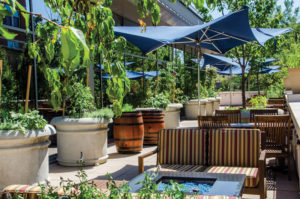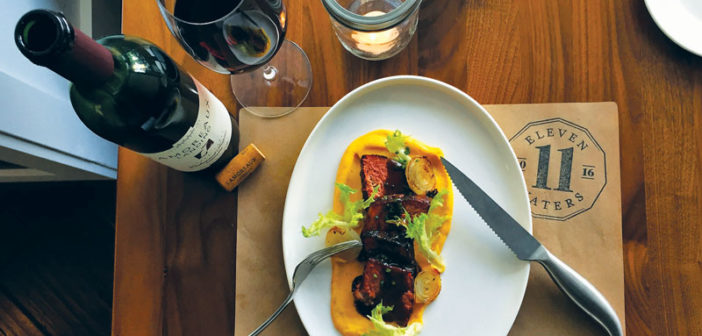FAIRFAX, VA—For a hotel management company, excelling at F&B can be a real boon. After all, done well, bars and restaurants can add to a hotel’s revenue stream. According to CBRE Hotels’ Americas Research, F&B venues in hotels amounted to a third of total F&B department revenue in 2016. For Crescent Hotels & Resorts, based here, getting these establishments right has been a leading area of focus.
Two years ago, the company committed to this strategy, creating a dedicated F&B operations team, led by Greg Griffie, SVP of food & beverage, and Rich Garcia, VP of culinary. “For us, F&B is a major part of what we do and what we believe in,” Griffie said. “When we’re underwriting hotels, get new hotels or we rate position existing hotels, food & beverage is always front and center in the conversation. We believe it’s a key component of the business—not an amenity—and one that needs to make money.”
Since the team’s inception, the executives have reinvented a number of restaurants by developing new concepts and turning them into destinations in their markets. In addition to creating concepts, Crescent’s F&B team also travels to each new Crescent hotel to specifically assess the needs of the restaurants and other food and drink services. “Our focus is strictly F&B and development, and understanding how to train our teams, how to become more profitable and how to curate better experiences,” Griffie said.
Griffie reflected on the ways F&B has changed over the years. “Years ago, when I started in the industry, hotels had a great dining scene, and then it went away,” he said. “Today, hotel dining has come back and has a place in most markets, but you really have to have a strong point of view and a story to tell. You can’t just be the continental dining rooms of the past and try to cater to everybody. You have to have a specific point of view, story and concept that people want to experience.”
The executive elaborated on how Crescent Hotels & Resorts goes about developing restaurant concepts. “When you’re looking at new projects, you have to really evaluate the local area,” he said. “We’re really looking for the void in the market, but also what resonates in the market, and then looking at the story you’ll tell.”

Vinifera Wine Bar & Bistro at The Westin Reston Heights in Reston, VA, at the gateway to Virginia wine country, supports local and regional producers.
It’s about both the market and the property itself: “Is there a story with the hotel or the surrounding area? Is there something you can tie into? Or a design element that we can tie into and really start a collaborative process from there?” he asked. “It’s a pretty collaborative process where we really take time to research the area, get to know it, and then work with our designers and owners to come up with what we want our point of view and the concept to look and feel like—and sound like, quite frankly.”
While sound may not be the first sense that comes to mind when picturing a desirable eating experience—taste, touch and sight all vie for that spot—sound is important. “The more hotel repositioning, restaurant concepting and openings we do, and the more we experience those openings, I think there’s a lot of missed opportunity around music programming, whether you notice it or not,” Griffie explained. “The most successful restaurants address…not just your taste and smell and touchpoint from your server, but the background music, and how it all engages you throughout the day. There’s a huge component there that many people miss and they don’t think about, but it can make you stay for another drink or grab a coffee. In today’s world, I don’t know that we always step back and think about pulling together the complete package.”
To create a successful F&B venue, hotels also need to make sure they give focus to the beverage part of the equation. “I think we all know the power of beverage,” he said. “Some of the best restaurants are very chef driven, but they’re chef driven with a great mixologist and great beverage program. I don’t see that going anywhere any time soon, and if you don’t put the efforts into the beverage and bar programming and then pull that through to the dining room, it’s a big miss. The days of not having cocktails in the dining room and only trying to focus on wine sales [are over]. You need a cocktail program that can start pre-dinner or at the table and then lead them into the wine.”
Griffie noted that one of the biggest challenges to creating a successful F&B venue is talent. “In today’s market, it’s really recruiting the right talent and then spending the time, effort and, quite frankly, money, on training the team on the greater vision,” he said. “The team that works in the restaurant or in the hotel has to understand the greater purpose of the food & beverage. Everybody needs to tell that story and that’s one of the biggest challenges—making sure that every team member, not just the restaurant staff or the lounge staff or the chef—understands the restaurant positioning and point of view, and what the concept is and why the guest should experience it. It’s that training of the entire hotel that can be challenging in today’s market.”
So, what are the major don’ts to avoid? Griffie named a few. “You can’t be everything to everybody. We’ve tried that in the hotel industry, and when we do that, that’s where we see F&B outlets that aren’t busy,” he said. “They’re a furniture showroom and no one is in it. It looks great, but there’s no business because the concept is either not strong enough, or it was a strong concept, but over time, hotel operators decided to be everything to everybody and have watered it down. When you look at your competition, they’re usually very specific and not trying to cater to everyone.”
Additionally, hotels have to keep authenticity in mind. “In today’s world, with social media and people being more food savvy, understanding where food comes from and how it’s prepared, you have to be authentic,” he said. HB


